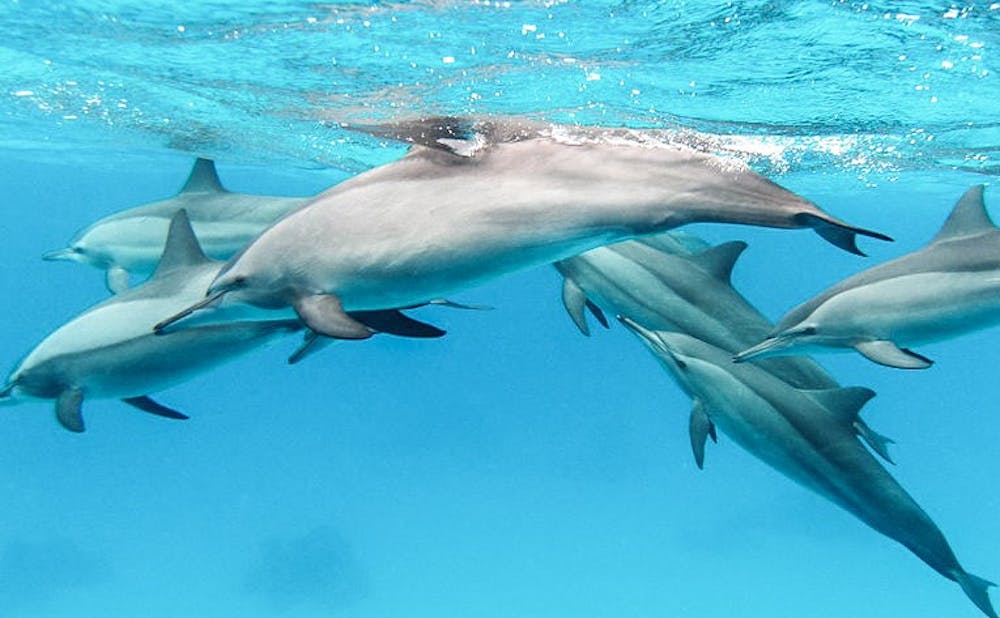Duke students are not the only ones that are sleep deprived. Researchers at Duke found that spinner dolphins in Hawaiian waters are unable to rest due to manmade noise.
In a study published last months, a group of marine scientists at the Nicholas School of the Environment monitored the sound pollution in four bays along the coast of Hawaii’s Kona District, home to spinner dolphins, by comparing the baseline sound level with the sound generated by human activities in these regions.
“Imagine you haven’t had a good night of sleep but have to do some work the next day—it doesn’t feel so good, especially when it happens over and over and over,” said Julian Tyne, a Ph.D. candidate at Murdoch University in Perth, Australia and an author on the study. “It is what’s happening with the [spinner] dolphins in Hawaii.”
A tsunami that struck Hawaii in 2011 led to a temporary halt in boat traffic nearby, said Heather Heenehan, primary author of the study and Ph.D. ’16. This provided the research team with the rare opportunity to measure the sound level in Hawaiian waters in the absence of human activities.
Heenehan and her team found that vessels, aquaculture and military mid-frequency active sonar are the three major sources of sound pollution in Hawaiian waters. According to their measurements, these sources could collectively create sound pulses 16 times higher than the baseline pulses.
Spinner dolphins who rest in the bays along the cost are especially vulnerable to sound pollution because they usually rest during the daytime and hunt offshore at night, Tyne said.
“Buffalo dolphins, [for example], can go forage almost anytime during the day,” Tyne said. “But the spinner dolphins have a more constrained daily activity pattern, making them less resilient to disturbance.”
Dolphins predominantly communicate through sound, Tyne said. The manmade sound pollution may also impede smooth communication between dolphins.
Heenehan said the influences of sound pollution on the spinner dolphins are wide and varied, though they are not the focus of this study. For example, sounds that are loud and close enough may even cause physical harm on the dolphins.
The distinctive sleeping behavior of the spinner dolphins has been hindered by eco-tourism, Heenehan said. Tourists often attempt to interact with the dolphins that rest in the bay, disturbing their sleep.
Researchers on the team deployed acoustic recorders in four bays along the Kona coast, Tyne said. They collected data every fourth night from the recorders to map the soundscape in each bay.
The recorders were only able to record 30 seconds of data every four minutes and require maintenance from time to time because of the limited storage of the SD cards in the recorders, Tyne said. Technology available today may enable the recorders to collect data continuously for about 12 months.
“But constantly maintaining the monitors does have benefits,” Tyne said. “If for some reason one of them does not record data, we are able to sort that issue out as soon as possible.”
In August 2016, the National Oceanic and Atmospheric Administration proposed a regulation to protect Hawaiian spinner dolphins which prohibited swimming with or approaching a dolphin within 50 yards by any means. However, its effects were not significant enough to combat the issue of disturbing the animals.
“The 50-yard, no-approach rule is not based on any scientific studies we have conducted,” Tyne said. “It is also hard to enforce in many ways.”
Measuring distance in the water is more difficult than on land, Tyne said. Plus, sometimes dolphins themselves will approach vessels and humans, making it hard to prevent close interaction.
Tyne said he and other researchers recommended a regional closure in the bays during specific time periods.
“The spinner dolphins in these areas are most likely to rest from 10 a.m. to 4 p.m.,” Tyne said. “We suggest to close these areas during this period as long as dolphins are present.”
Human activities vary across bays and generate different combinations of noises, said David Johnston, associate professor of the practice of marine conservation ecology and another author on the study, in an interview with the Nicholas School. Policymakers need to individualize rules to mitigate sound pollution in different areas, he added.
“No one-size-fits-all approach will work,” Johnston said in the interview.
Tyne said future studies should continue to monitor the sound level in the bays to measure the pollution over time. Researchers should also track the number of spinner dolphins to evaluate the potential effects of human activities on the their population.
Get The Chronicle straight to your inbox
Signup for our weekly newsletter. Cancel at any time.

